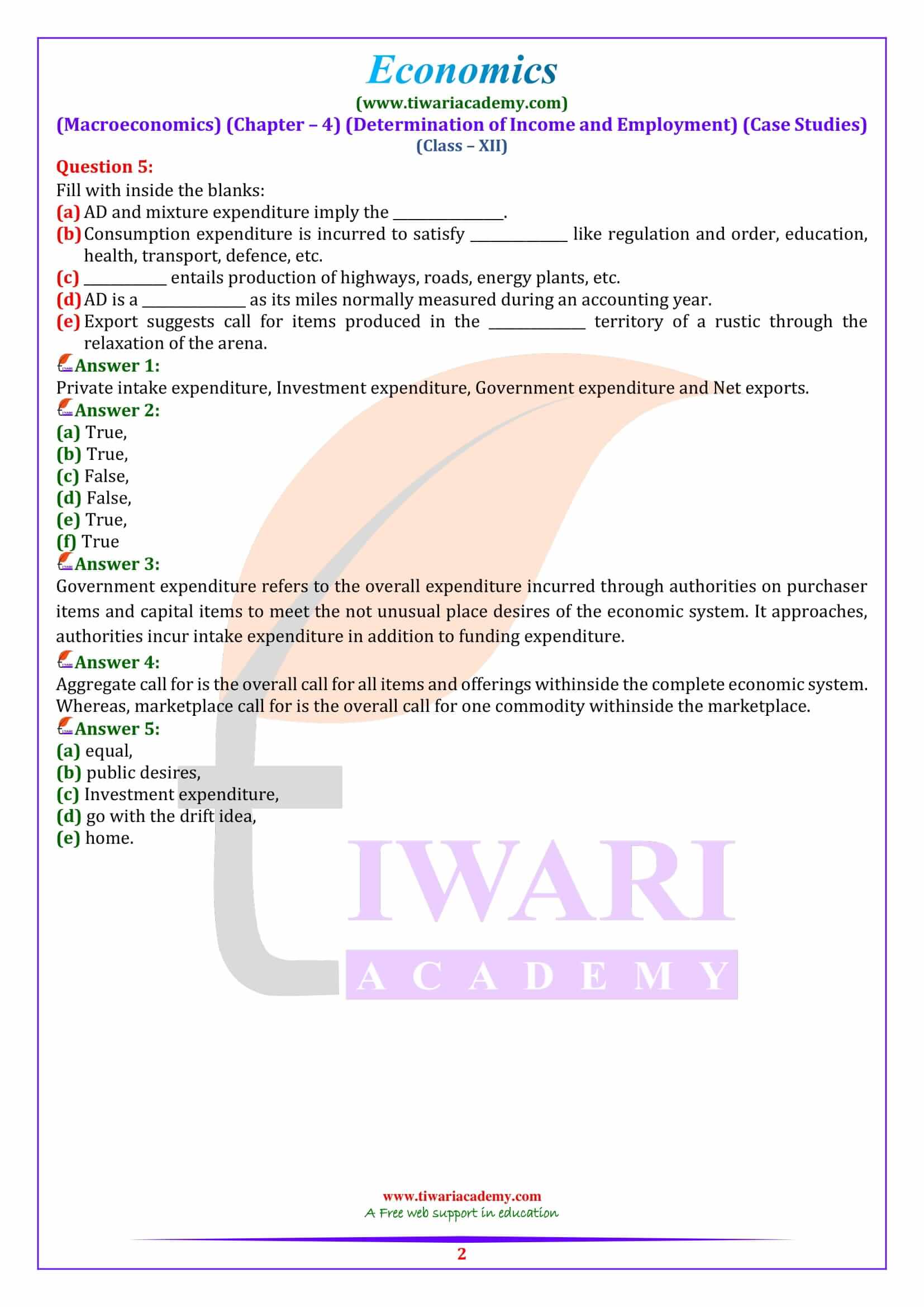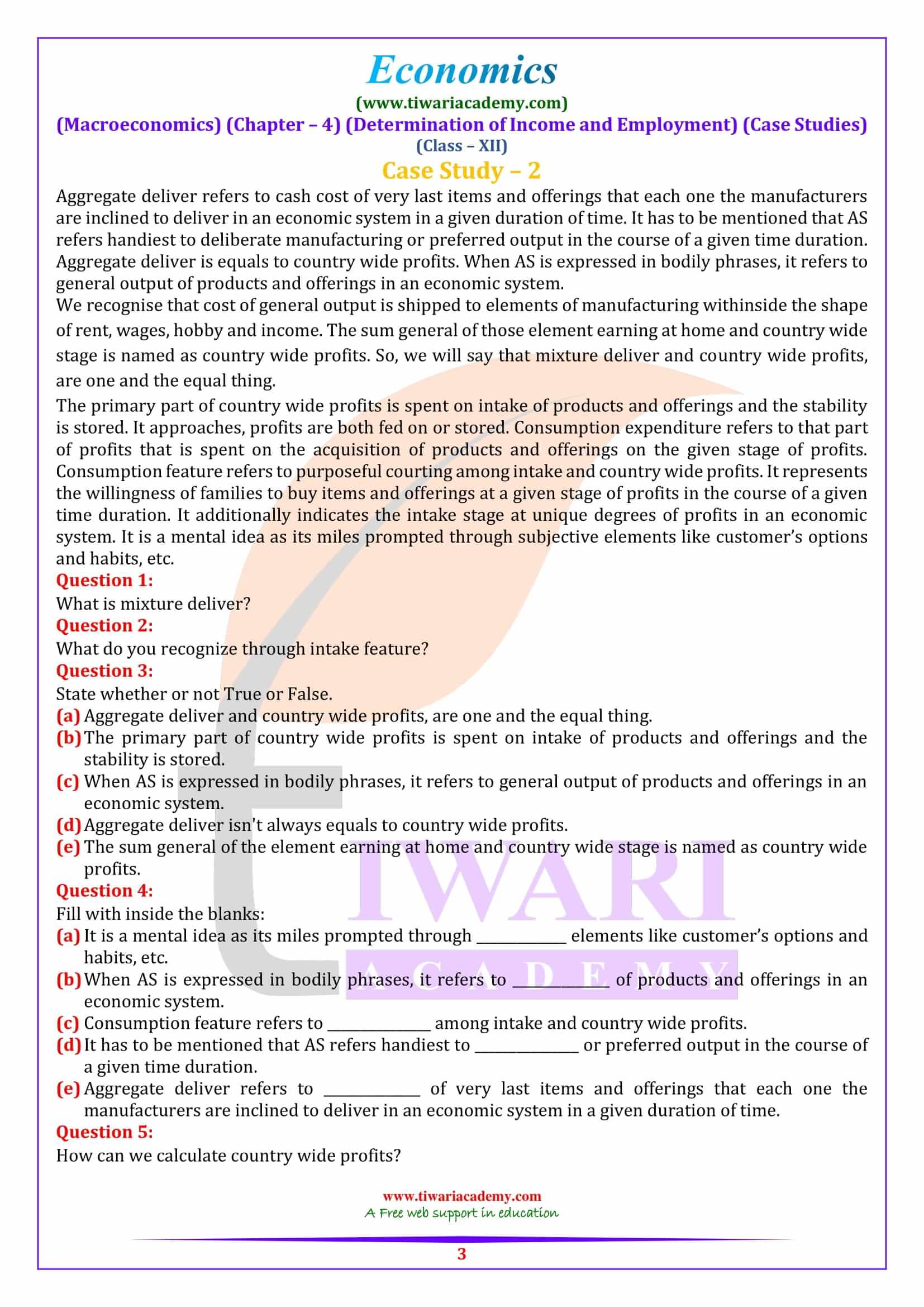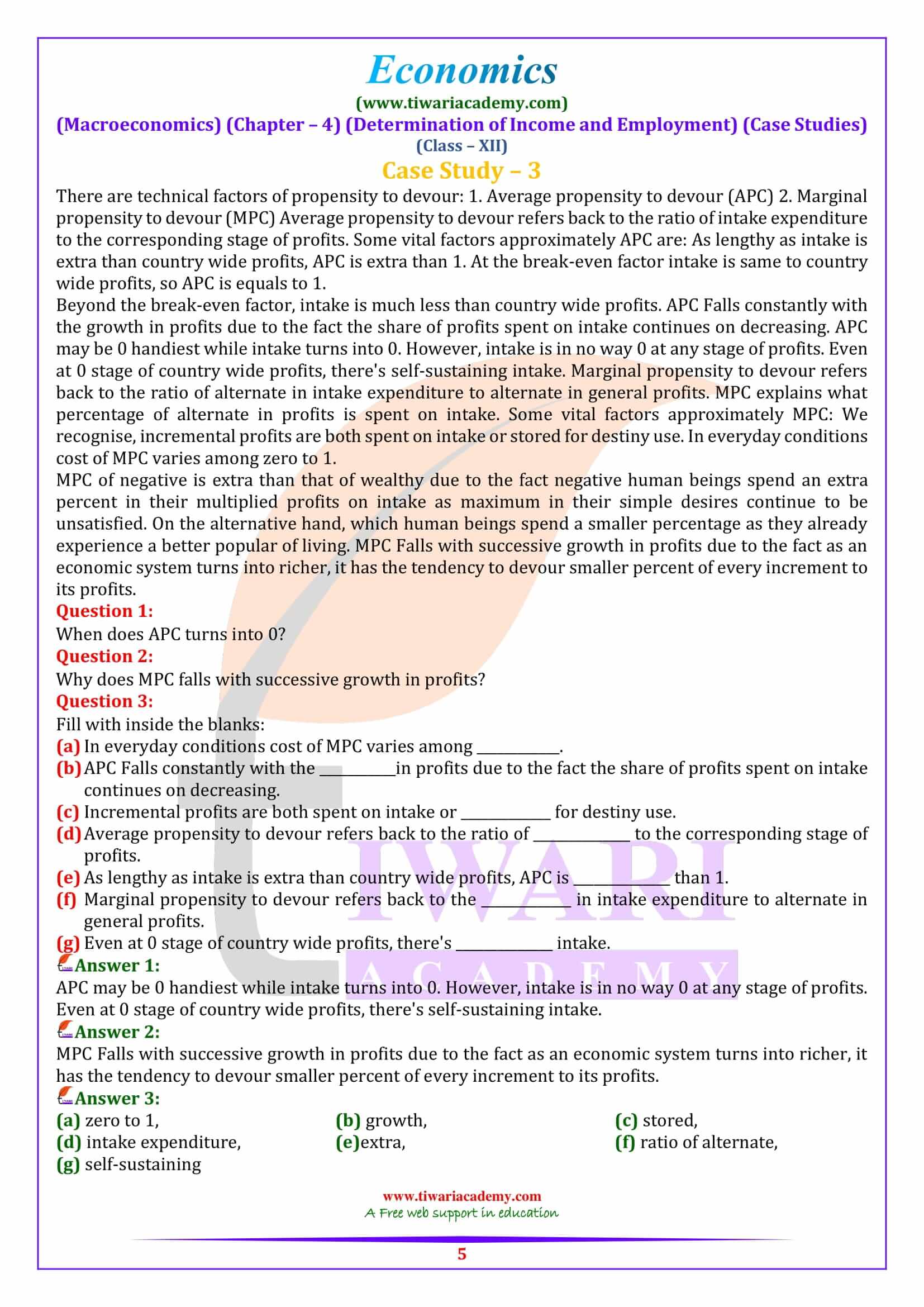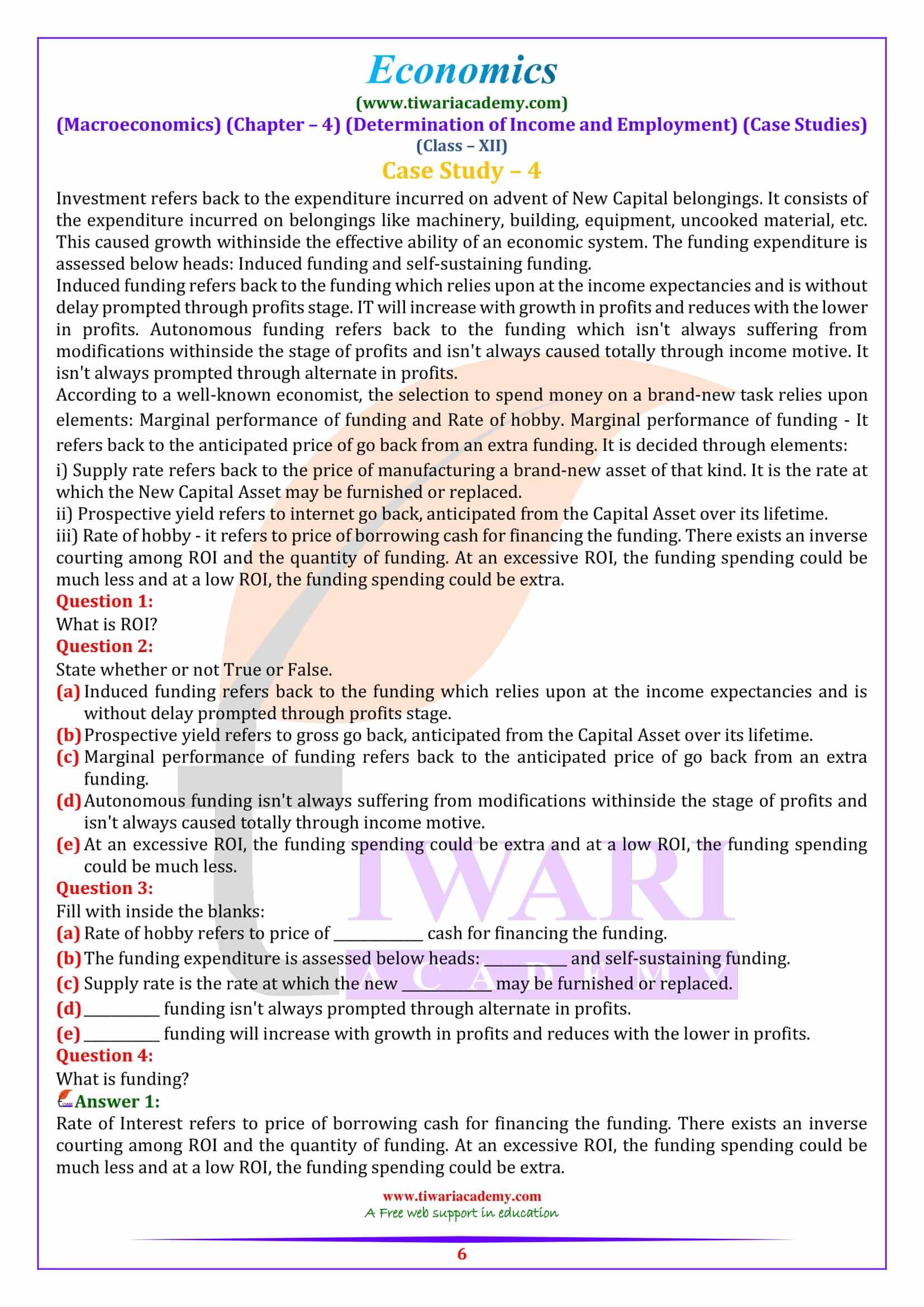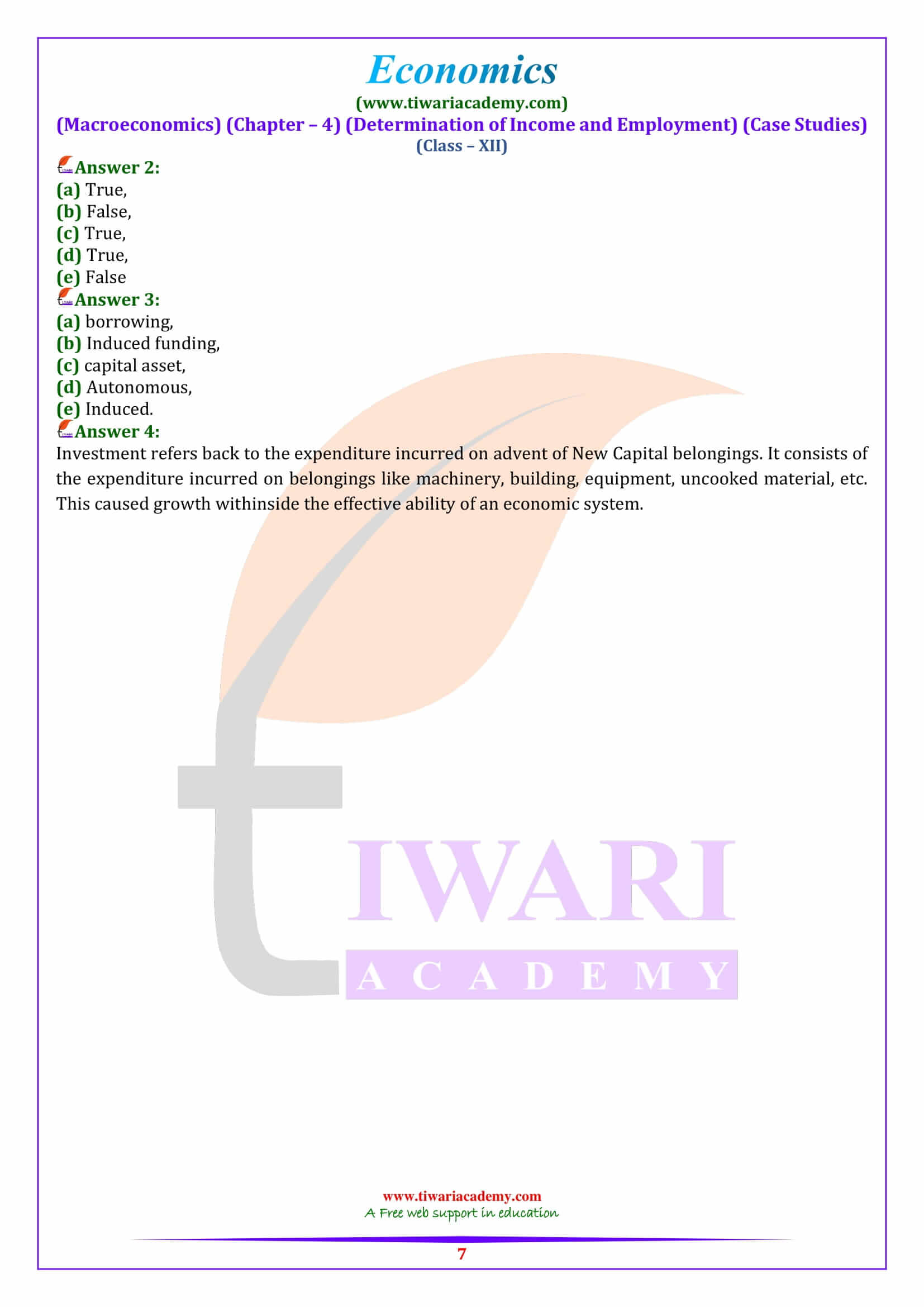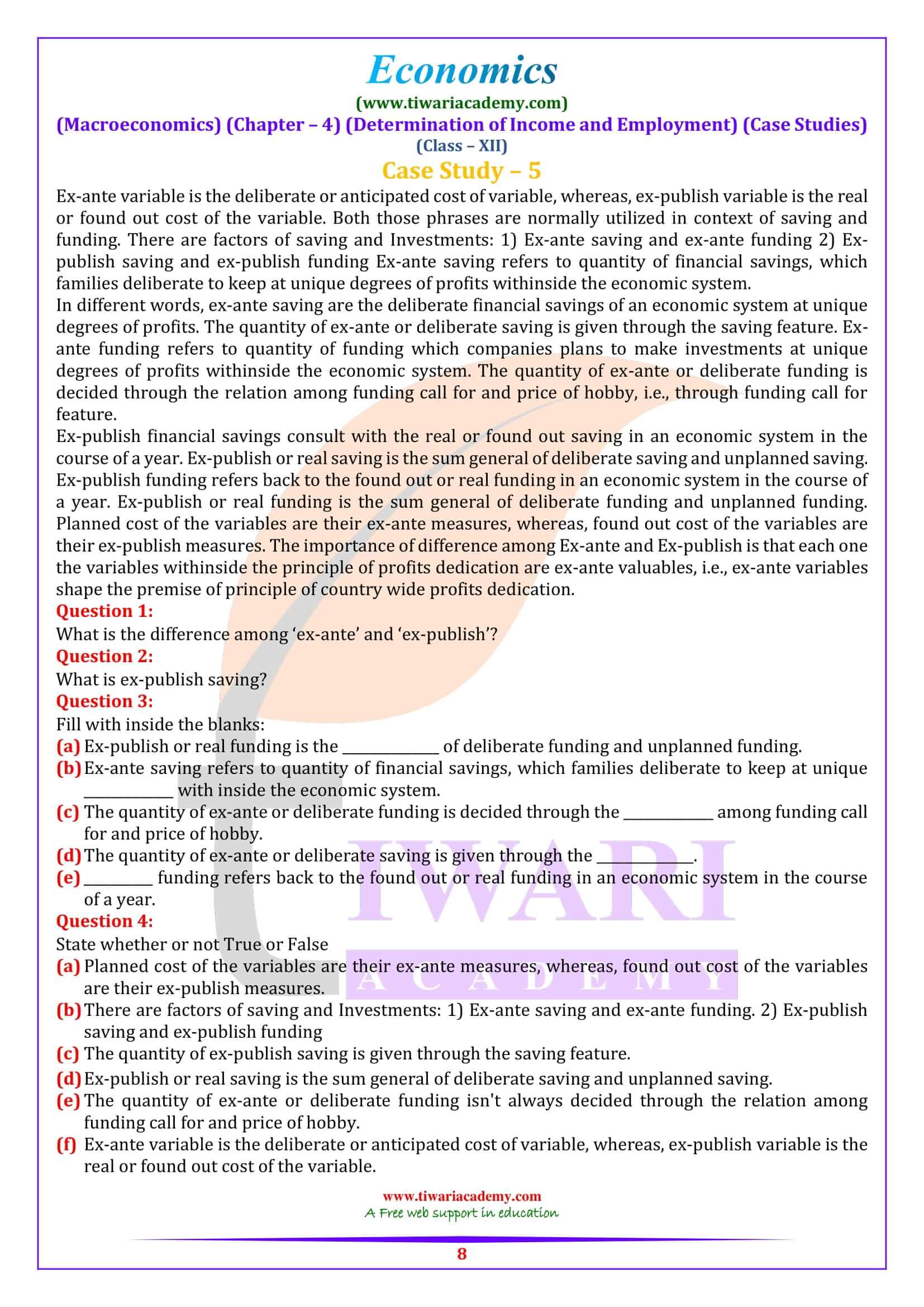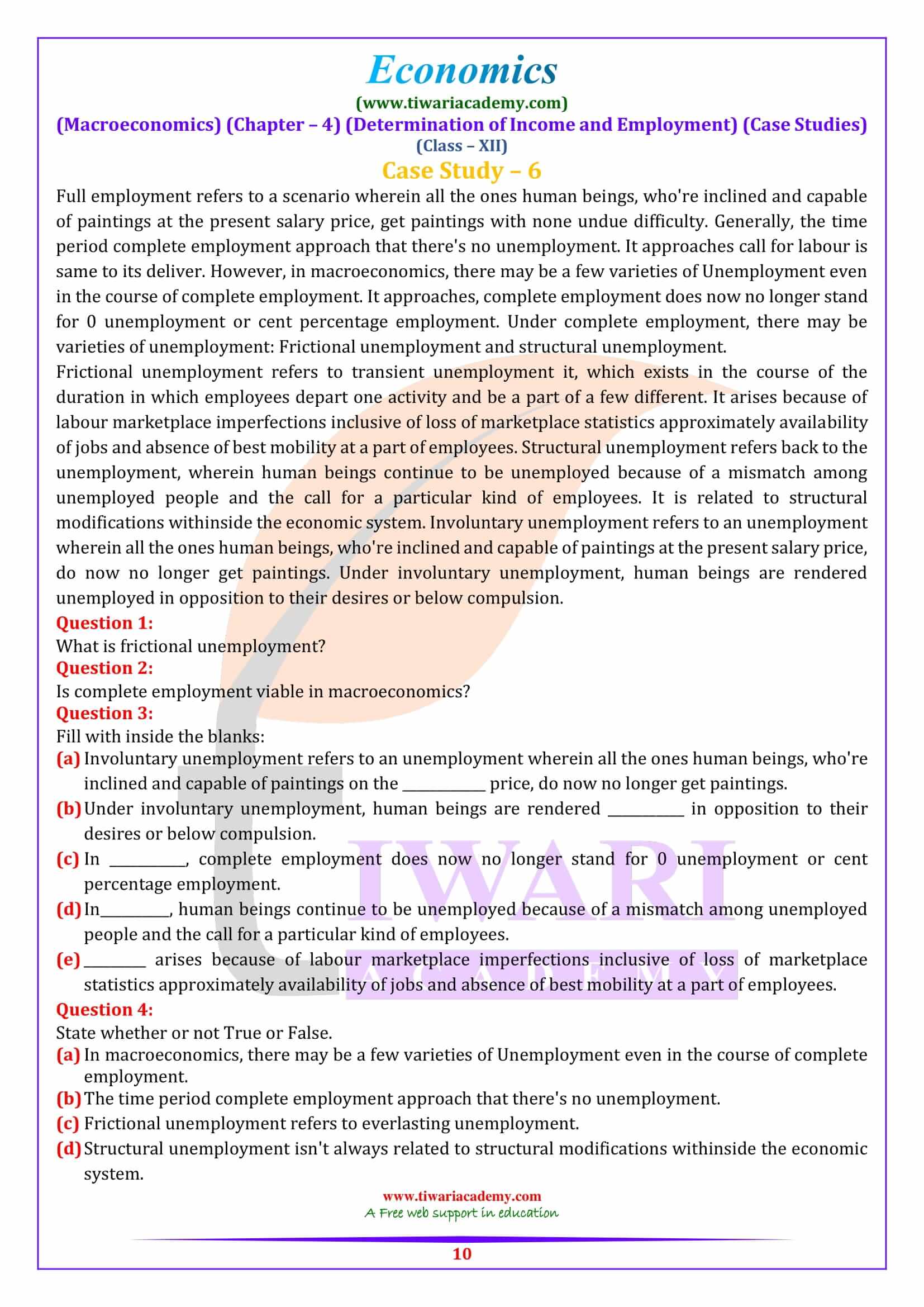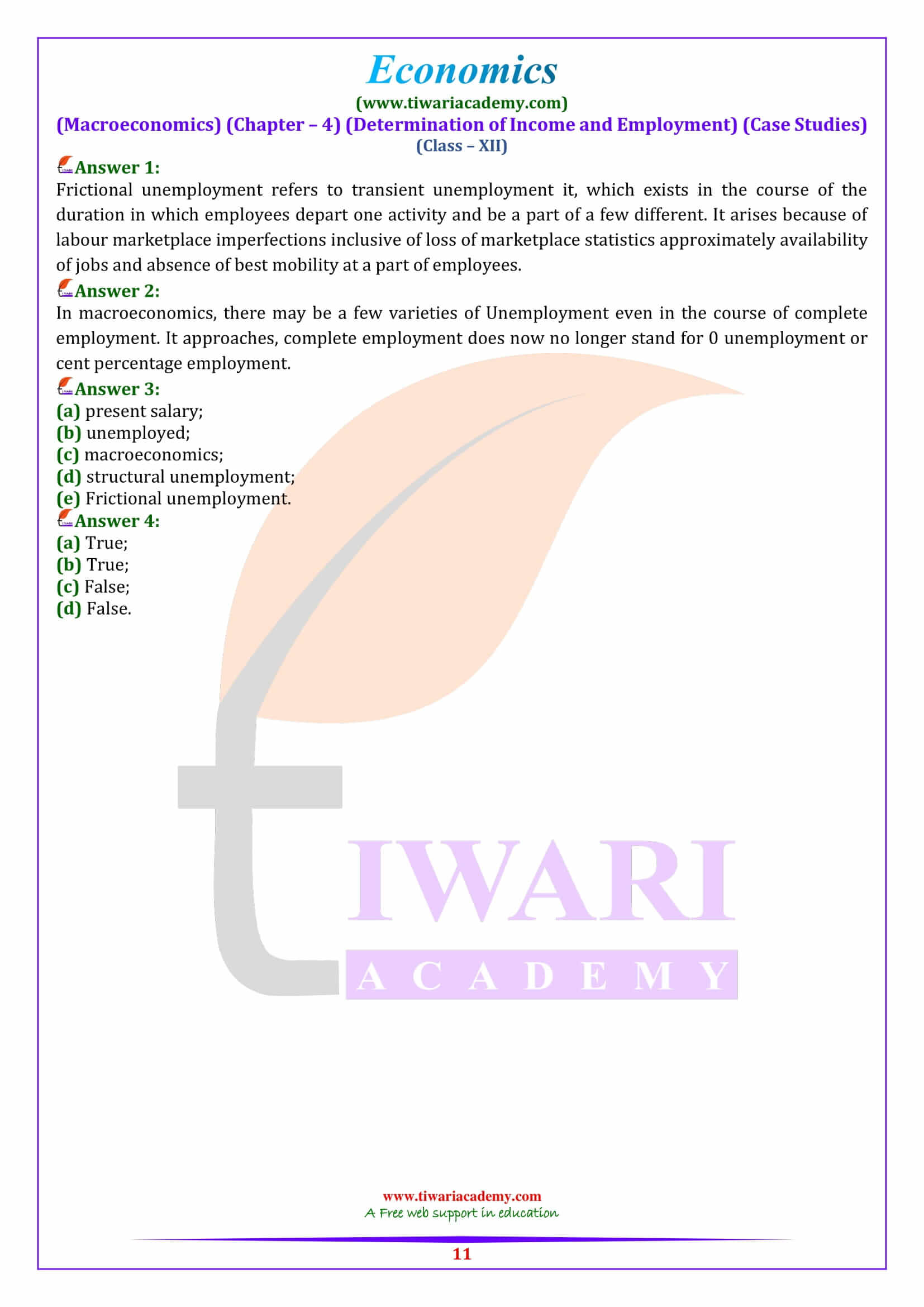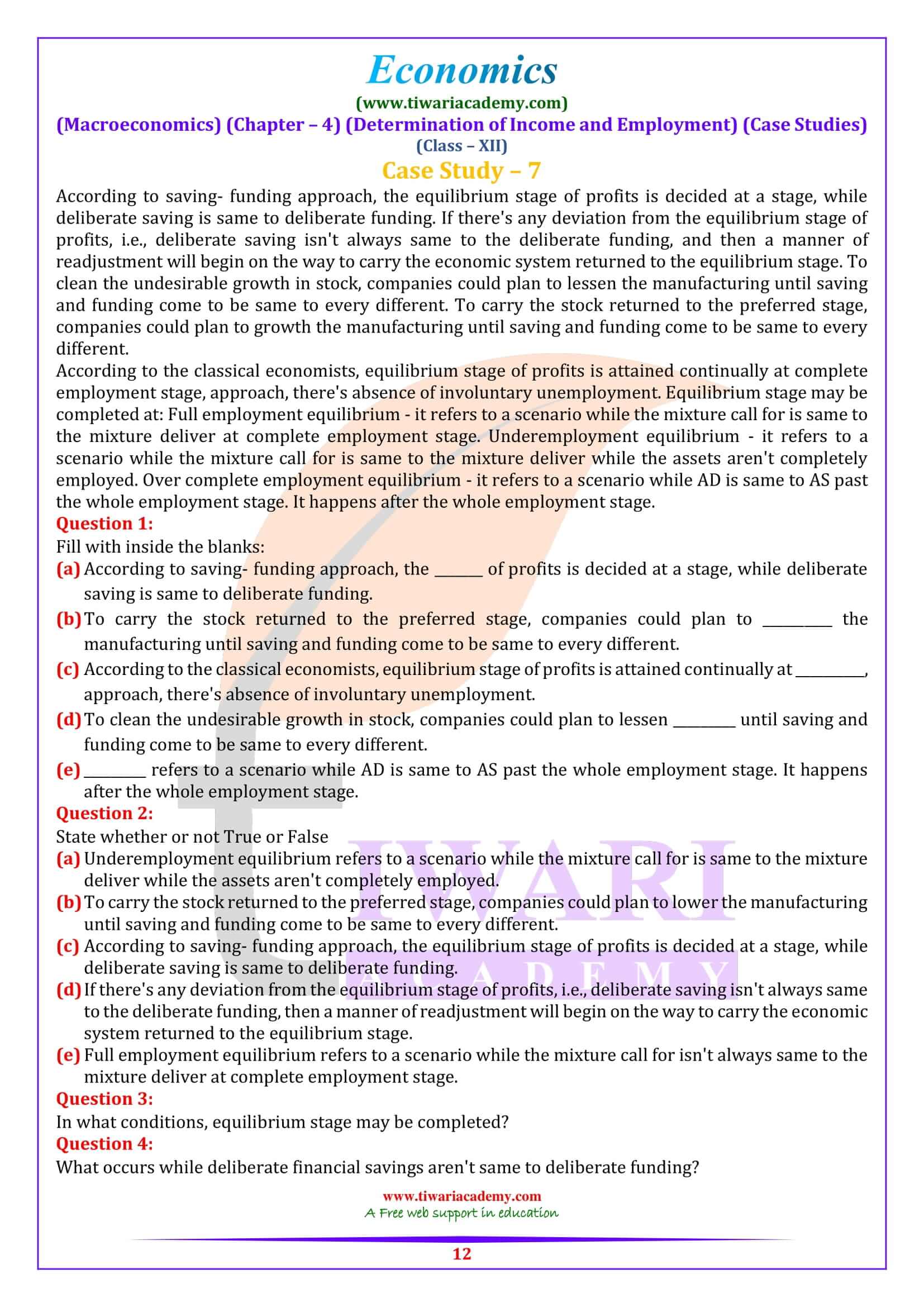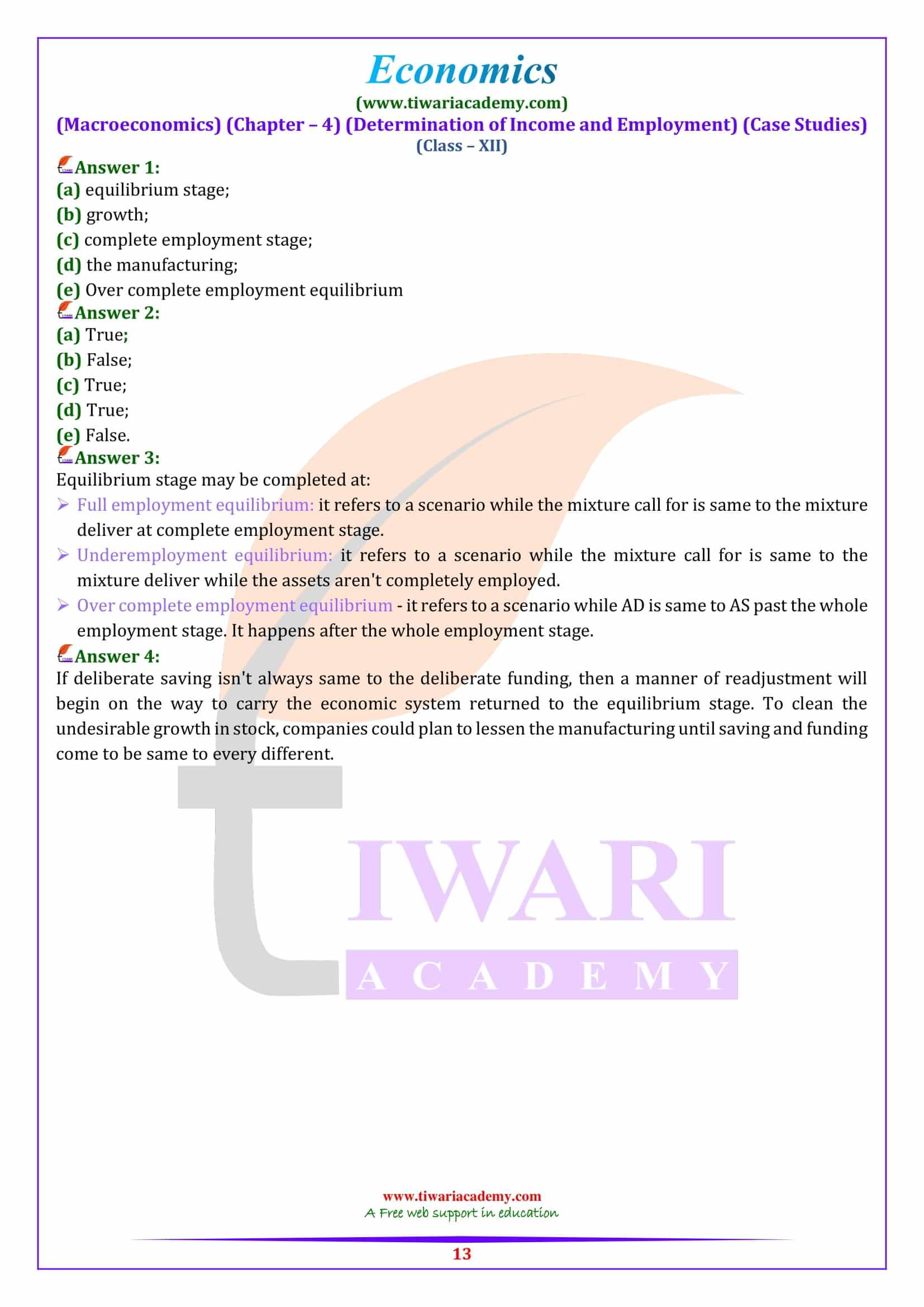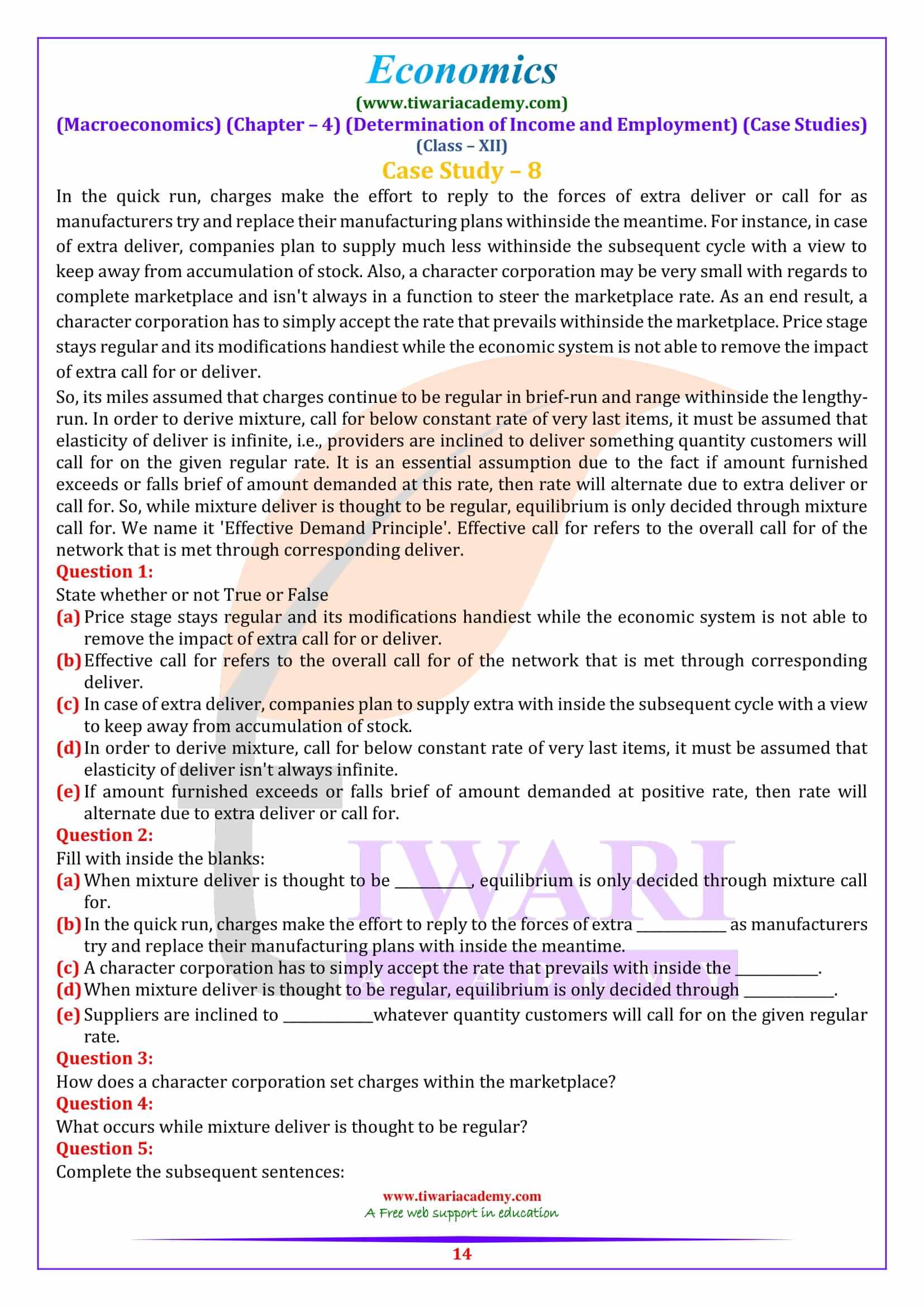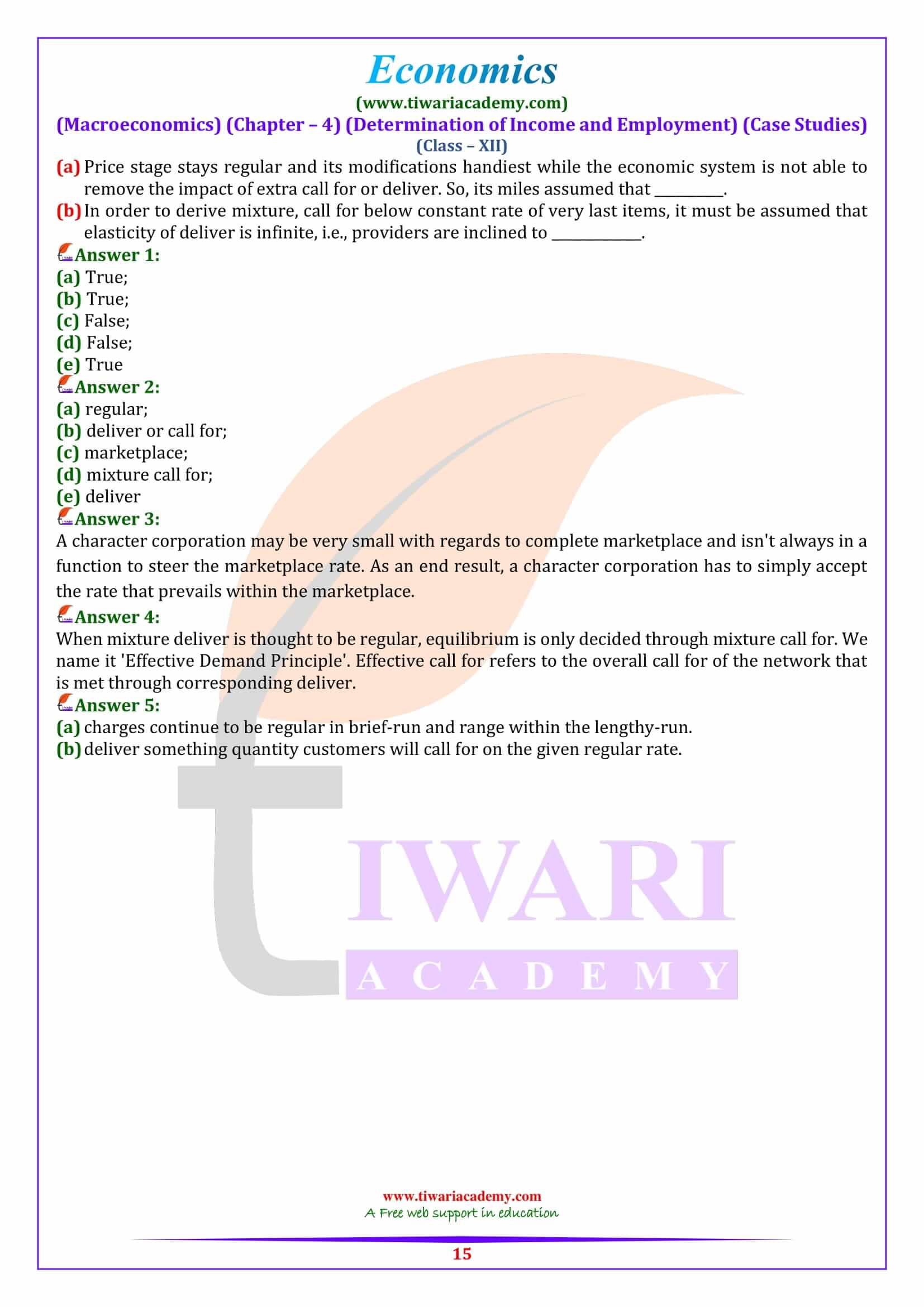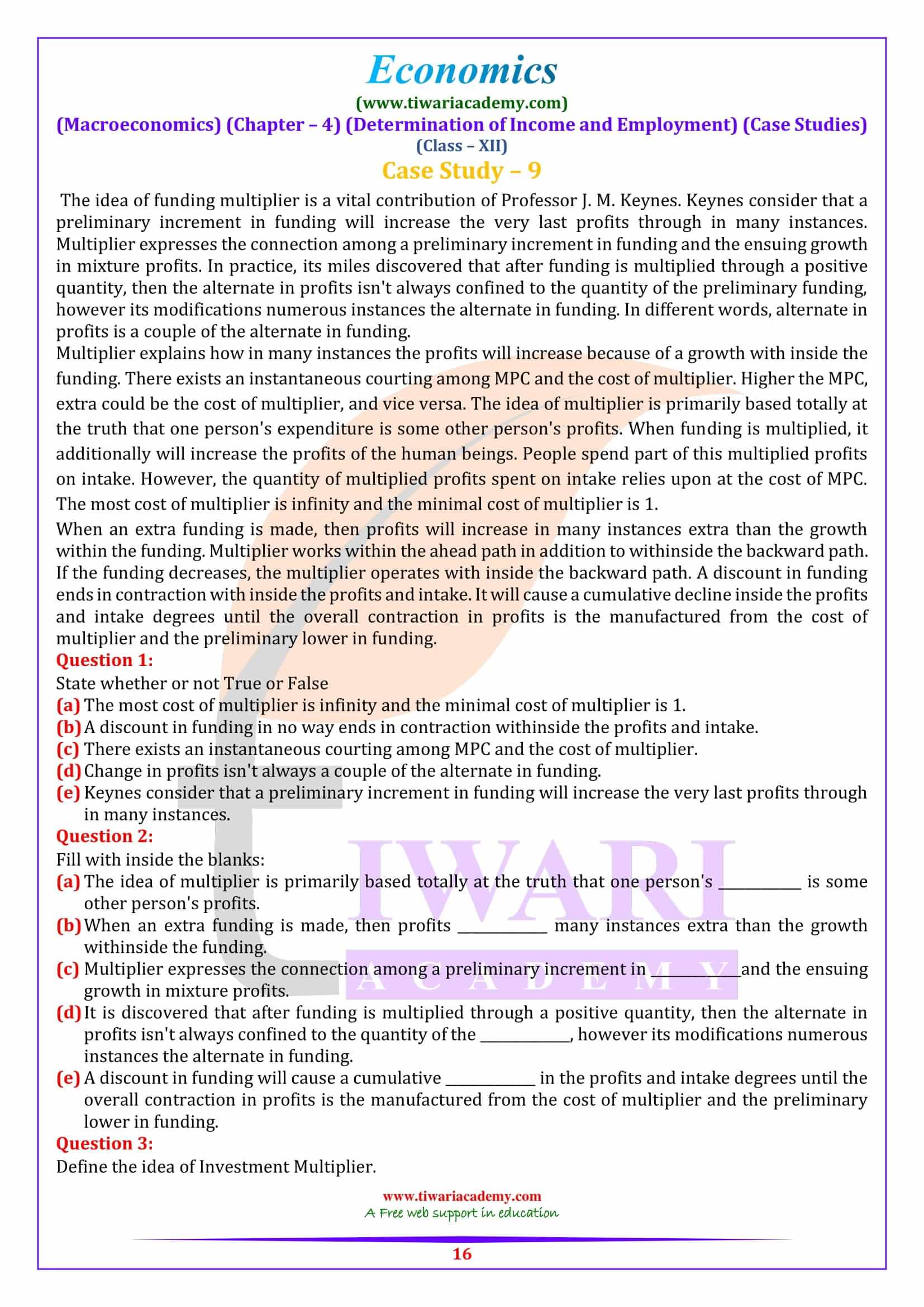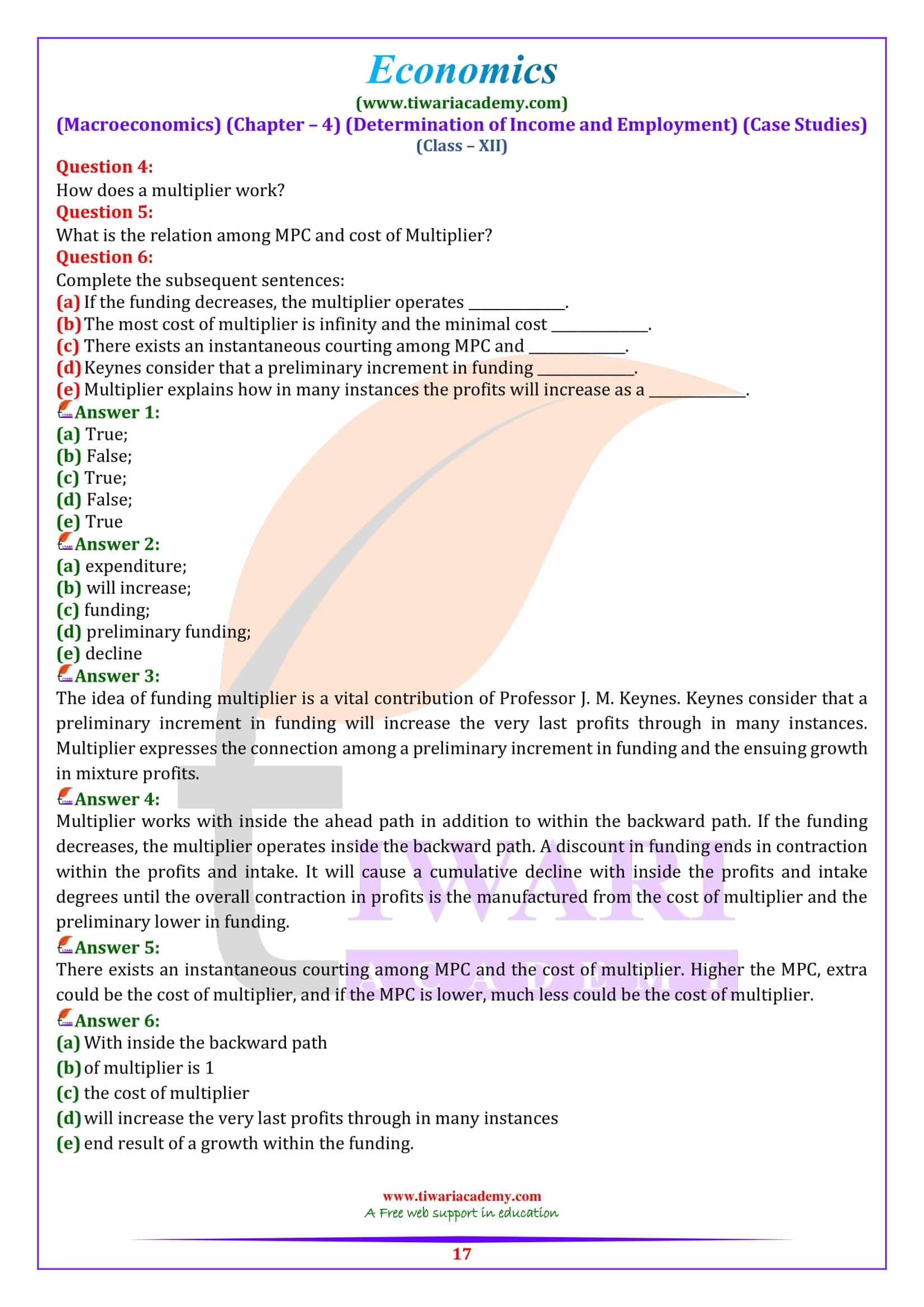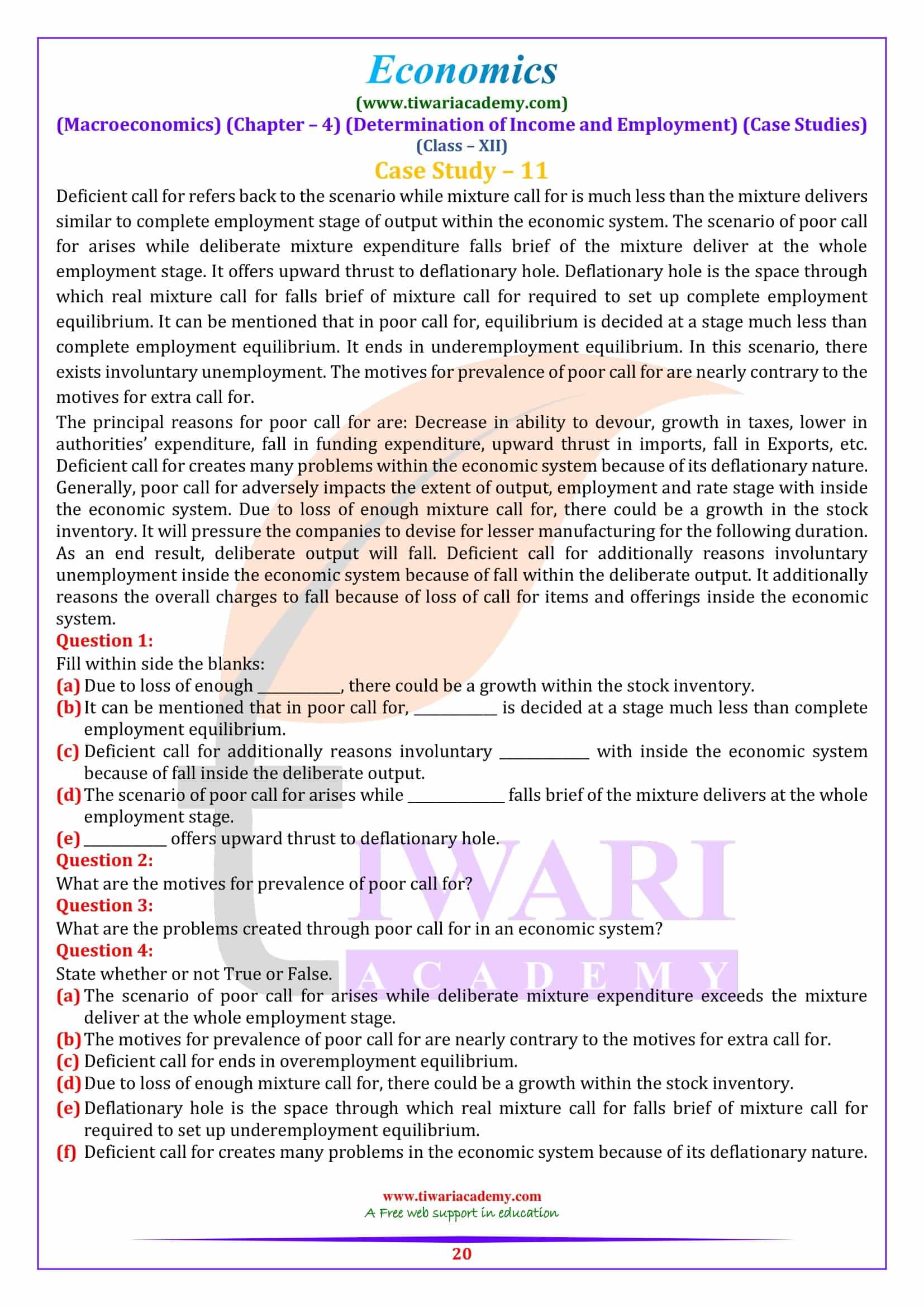NCERT Solutions for Class 12 Macroeconomics Chapter 4 Case Study Questions with answers in English Medium designed for session 2025-26. The Case Study MCQ of class 12 Economics chapter 4 Determination of Income and Employment are given here to understand Case Studies and to prepare the Case based questions.
Class 12 Macroeconomics Chapter 4 Case Studies Question Answers
Class 12 Macroeconomics Chapter 4 Case Study: 1
Aggregate call for refers to the overall cost of very last items and offerings which all of the sectors of an economic system are making plans to shop for at a given stage of profits in the course of a duration of 1 accounting year. In different words, AD is the mixture expenditure that unique sectors of the economic system are inclined to incur in the course of a given duration. It approaches, AD and mixture expenditure imply the equal. It is vital to notice that mixture expenditure refers back to the deliberate expenditure and now no longer the real expenditure. So, AD is the overall costs that each one family, companies, authorities and the relaxation of the arena are making plans to incur in the course of a given duration of time. AD is a go with the drift idea as its miles normally measured during an accounting year.
Components of mixture call for: The diverse additives of mixture call for are:
- Private intake expenditure – It refers to the overall expenditure incurred through families on buy of products and offerings in the course of an accounting year. Consumption expenditure is without delay prompted through the extent of disposable profits i.e., better the disposable profits, extra is the intake expenditure and vice versa. Disposable profits refer back to the profits from all sources that is to be had to families for spending on intake and saving.
- Investment expenditure – It refers to the overall expenditure incurred through all non-public companies on capital items. It consists of addition to the inventory of bodily capital belongings inclusive of machinery, equipment, homes etc. and alternate in stock.
- Government expenditure – It refers to the overall expenditure incurred through authorities on purchaser items and capital items to meet the not unusual place desires of the economic system. It approaches, authorities incur intake expenditure in addition to funding expenditure. Consumption expenditure is incurred to satisfy public desires like regulation and order, education, health, transport, defence, etc. Investment expenditure entails production of highways, roads, energy plants, etc.
- Net Exports – Export suggest call for items produced in the home territory of a rustic through the relaxation of the arena. Imports consult with needs of the citizens of a rustic for the products which have been produced abroad. The distinction among exports and imports is named as NET Exports.
- Question 1:
Name the 4 additives of mixture call for. - Question 2:
State whether or not True or False.
(a) AD and mixture expenditure imply the equal.
(b) AD is the overall costs that each one family, companies, authorities and the relaxation of the arena are making plans to incur in the course of a given duration of time.
(c) Imports consult with needs of the citizens of a rustic for the products which have been produced in a rustic.
(d) The distinction among exports and imports is named as Gross Exports.
(e) AD is a go with the drift idea as its miles normally measured during an accounting year.
(f) Investment expenditure consists of addition to the inventory of bodily capital belongings inclusive of machinery, equipment, homes etc. and alternate in stock. - Question 3:
What is Government expenditure? - Question 4:
What is mixture call for and marketplace call for? - Question 5:
Fill with inside the blanks:
(a) AD and mixture expenditure imply the _________.
(b) Consumption expenditure is incurred to satisfy _________ like regulation and order, education, health, transport, defence, etc.
(c) ________ entails production of highways, roads, energy plants, etc.
(d) AD is a _________ as its miles normally measured during an accounting year.
(e) Export suggests call for items produced in the _________ territory of a rustic through the relaxation of the arena.
- Answer 1:
Private intake expenditure, Investment expenditure, Government expenditure and Net exports. - Answer 2:
(a) True,
(b) True,
(c) False,
(d) False,
(e) True,
(f) True - Answer 3:
Government expenditure refers to the overall expenditure incurred through authorities on purchaser items and capital items to meet the not unusual place desires of the economic system. It approaches, authorities incur intake expenditure in addition to funding expenditure. - Answer 4:
Aggregate call for is the overall call for all items and offerings inside the complete economic system. Whereas, marketplace call for is the overall call for one commodity within the marketplace. - Answer 5:
(a) equal,
(b) public desires,
(c) Investment expenditure,
(d) go with the drift idea,
(e) home.
Class 12 Macroeconomics Chapter 4 Case Study: 2
Aggregate deliver refers to cash cost of very last items and offerings that each one the manufacturers are inclined to deliver in an economic system in a given duration of time. It has to be mentioned that AS refers handiest to deliberate manufacturing or preferred output in the course of a given time duration. Aggregate deliver is equals to country wide profits. When AS is expressed in bodily phrases, it refers to general output of products and offerings in an economic system.
We recognise that cost of general output is shipped to elements of manufacturing within the shape of rent, wages, hobby and income. The sum general of those element earning at home and country wide stage is named as country wide profits. So, we will say that mixture deliver and country wide profits, are one and the equal thing.
The primary part of country wide profits is spent on intake of products and offerings and the stability is stored. It approaches, profits are both fed on or stored. Consumption expenditure refers to that part of profits that is spent on the acquisition of products and offerings on the given stage of profits. Consumption feature refers to purposeful courting among intake and country wide profits. It represents the willingness of families to buy items and offerings at a given stage of profits in the course of a given time duration. It additionally indicates the intake stage at unique degrees of profits in an economic system. It is a mental idea as its miles prompted through subjective elements like customer’s options and habits, etc.
- Question 1:
What is mixture deliver? - Question 2:
What do you recognize through intake feature? - Question 3:
State whether or not True or False.
(a) Aggregate deliver and country wide profits, are one and the equal thing.
(b) The primary part of country wide profits is spent on intake of products and offerings and the stability is stored.
(c) When AS is expressed in bodily phrases, it refers to general output of products and offerings in an economic system.
(d) Aggregate deliver isn’t always equals to country wide profits.
(e) The sum general of the element earning at home and country wide stage is named as country wide profits. - Question 4:
Fill with inside the blanks:
(a) It is a mental idea as its miles prompted through _____________ elements like customer’s options and habits, etc.
(b) When AS is expressed in bodily phrases, it refers to ______________ of products and offerings in an economic system.
(c) Consumption feature refers to _______________ among intake and country wide profits.
(d) It has to be mentioned that AS refers handiest to _______________ or preferred output in the course of a given time duration.
(e) Aggregate deliver refers to ______________ of very last items and offerings that each one the manufacturers are inclined to deliver in an economic system in a given duration of time. - Question 5:
How can we calculate country wide profits?
- Answer 1:
Aggregate deliver refers to cash cost of very last items and offerings that each one the manufacturers are inclined to deliver in an economic system in a given duration of time. - Answer 2:
Consumption feature refers to purposeful courting among intake and country wide profits. It represents the willingness of families to buy items and offerings at a given stage of profits in the course of a given time duration. - Answer 3:
(a) True,
(b) True,
(c) True,
(d) False,
(e) False - Answer 4:
(a) subjective,
(b) general output,
(c) purposeful courting,
(d) deliberate manufacturing,
(e) cash cost - Answer 5:
The cost of general output is shipped to elements of manufacturing inside the shape of rent, wages, hobby and income. The sum general of those element earning at home and country wide stage is named as country wide profits.
Class 12 Macroeconomics Chapter 4 Case Study: 3
There are technical factors of propensity to devour: 1. Average propensity to devour (APC) 2. Marginal propensity to devour (MPC) Average propensity to devour refers back to the ratio of intake expenditure to the corresponding stage of profits. Some vital factors approximately APC are: As lengthy as intake is extra than country wide profits, APC is extra than 1. At the break-even factor intake is same to country wide profits, so APC is equals to 1.
Beyond the break-even factor, intake is much less than country wide profits. APC Falls constantly with the growth in profits due to the fact the share of profits spent on intake continues on decreasing. APC may be 0 handiest while intake turns into 0. However, intake is in no way 0 at any stage of profits. Even at 0 stage of country wide profits, there’s self-sustaining intake. Marginal propensity to devour refers back to the ratio of alternate in intake expenditure to alternate in general profits. MPC explains what percentage of alternate in profits is spent on intake. Some vital factors approximately MPC: We recognise, incremental profits are both spent on intake or stored for destiny use. In everyday conditions cost of MPC varies among zero to 1.
MPC of negative is extra than that of wealthy due to the fact negative human beings spend an extra percent in their multiplied profits on intake as maximum in their simple desires continue to be unsatisfied. On the alternative hand, which human beings spend a smaller percentage as they already experience a better popular of living. MPC Falls with successive growth in profits due to the fact as an economic system turns into richer, it has the tendency to devour smaller percent of every increment to its profits.
- Question 1:
When does APC turns into 0? - Question 2:
Why does MPC falls with successive growth in profits? - Question 3:
Fill with inside the blanks:
(a) In everyday conditions cost of MPC varies among ____________.
(b) APC Falls constantly with the ___________in profits due to the fact the share of profits spent on intake continues on decreasing.
(c) Incremental profits are both spent on intake or _____________ for destiny use.
(d) Average propensity to devour refers back to the ratio of ______________ to the corresponding stage of profits.
(e) As lengthy as intake is extra than country wide profits, APC is ______________ than 1.
(f) Marginal propensity to devour refers back to the _____________ in intake expenditure to alternate in general profits.
(g) Even at 0 stage of country wide profits, there’s ______________ intake.
- Answer 1:
APC may be 0 handiest while intake turns into 0. However, intake is in no way 0 at any stage of profits. Even at 0 stage of country wide profits, there’s self-sustaining intake. - Answer 2:
MPC Falls with successive growth in profits due to the fact as an economic system turns into richer, it has the tendency to devour smaller percent of every increment to its profits. - Answer 3:
(a) zero to 1, (b) growth, (c) stored,
(d) intake expenditure, (e)extra, (f) ratio of alternate,
(g) self-sustaining
Class 12 Macroeconomics Chapter 4 Case Study: 4
Investment refers back to the expenditure incurred on advent of New Capital belongings. It consists of the expenditure incurred on belongings like machinery, building, equipment, uncooked material, etc. This caused growth inside the effective ability of an economic system. The funding expenditure is assessed below heads: Induced funding and self-sustaining funding.
Induced funding refers back to the funding which relies upon at the income expectancy and is without delay prompted through profits stage. IT will increase with growth in profits and reduces with the lower in profits. Autonomous funding refers back to the funding which isn’t always suffering from modifications within the stage of profits and isn’t always caused totally through income motive. It isn’t always prompted through alternate in profits.
According to a well-known economist, the selection to spend money on a brand-new task relies upon elements: Marginal performance of funding and Rate of hobby. Marginal performance of funding – It refers back to the anticipated price of go back from an extra funding. It is decided through elements:
- Supply rate refers back to the price of manufacturing a brand-new asset of that kind. It is the rate at which the New Capital Asset may be furnished or replaced.
- Prospective yield refers to internet go back, anticipated from the Capital Asset over its lifetime.
- Rate of hobby – it refers to price of borrowing cash for financing the funding. There exists an inverse courting among ROI and the quantity of funding. At an excessive ROI, the funding spending could be much less and at a low ROI, the funding spending could be extra.
- Question 1:
What is ROI? - Question 2:
State whether or not True or False.
(a) Induced funding refers back to the funding which relies upon at the income expectancy and is without delay prompted through profits stage.
(b) Prospective yield refers to gross go back, anticipated from the Capital Asset over its lifetime.
(c) Marginal performance of funding refers back to the anticipated price of go back from an extra funding.
(d) Autonomous funding isn’t always suffering from modifications within the stage of profits and isn’t always caused totally through income motive.
(e) At an excessive ROI, the funding spending could be extra and at a low ROI, the funding spending could be much less. - Question 3:
Fill with inside the blanks:
(a) Rate of hobby refers to price of _____________ cash for financing the funding.
(b) The funding expenditure is assessed below heads: ____________ and self-sustaining funding.
(c) Supply rate is the rate at which the new _____________ may be furnished or replaced.
(d) ___________ funding isn’t always prompted through alternate in profits.
(e) ___________ funding will increase with growth in profits and reduces with the lower in profits. - Question 4:
What is funding?
- Answer 1:
Rate of Interest refers to price of borrowing cash for financing the funding. There exists an inverse courting among ROI and the quantity of funding. At an excessive ROI, the funding spending could be much less and at a low ROI, the funding spending could be extra. - Answer 2:
(a) True,
(b) False,
(c) True,
(d) True,
(e) False - Answer 3:
(a) borrowing,
(b) Induced funding,
(c) capital asset,
(d) Autonomous,
(e) Induced. - Answer 4:
Investment refers back to the expenditure incurred on advent of New Capital belongings. It consists of the expenditure incurred on belongings like machinery, building, equipment, uncooked material, etc. This caused growth within the effective ability of an economic system.
Class 12 Macroeconomics Chapter 4 Case Study: 5
Ex-ante variable is the deliberate or anticipated cost of variable, whereas, ex-publish variable is the real or found out cost of the variable. Both those phrases are normally utilized in context of saving and funding. There are factors of saving and Investments: 1) Ex-ante saving and ex-ante funding 2) Ex-publish saving and ex-publish funding Ex-ante saving refers to quantity of financial savings, which families deliberate to keep at unique degrees of profits in the economic system.
In different words, ex-ante saving are the deliberate financial savings of an economic system at unique degrees of profits. The quantity of ex-ante or deliberate saving is given through the saving feature. Ex-ante funding refers to quantity of funding which companies plans to make investments at unique degrees of profits within the economic system. The quantity of ex-ante or deliberate funding is decided through the relation among funding call for and price of hobby, i.e., through funding call for feature.
Ex-publish financial savings consult with the real or found out saving in an economic system in the course of a year. Ex-publish or real saving is the sum general of deliberate saving and unplanned saving. Ex-publish funding refers back to the found out or real funding in an economic system in the course of a year. Ex-publish or real funding is the sum general of deliberate funding and unplanned funding. Planned cost of the variables are their ex-ante measures, whereas, found out cost of the variables are their ex-publish measures. The importance of difference among Ex-ante and Ex-publish is that each one the variables inside the principle of profits dedication are ex-ante valuables, i.e., ex-ante variables shape the premise of principle of country wide profits dedication.
- Question 1:
What is the difference among ‘ex-ante’ and ‘ex-publish’? - Question 2:
What is ex-publish saving? - Question 3:
Fill with inside the blanks:
(a) Ex-publish or real funding is the ______________ of deliberate funding and unplanned funding.
(b) Ex-ante saving refers to quantity of financial savings, which families deliberate to keep at unique _____________ with inside the economic system.
(c) The quantity of ex-ante or deliberate funding is decided through the _____________ among funding call for and price of hobby.
(d) The quantity of ex-ante or deliberate saving is given through the ______________.
(e) __________ funding refers back to the found out or real funding in an economic system in the course of a year. - Question 4:
State whether or not True or False
(a) Planned cost of the variables are their ex-ante measures, whereas, found out cost of the variables are their ex-publish measures.
(b) There are factors of saving and Investments: 1) Ex-ante saving and ex-ante funding. 2) Ex-publish saving and ex-publish funding
(c) The quantity of ex-publish saving is given through the saving feature.
(d) Ex-publish or real saving is the sum general of deliberate saving and unplanned saving.
(e) The quantity of ex-ante or deliberate funding isn’t always decided through the relation among funding call for and price of hobby.
(f) Ex-ante variable is the deliberate or anticipated cost of variable, whereas, ex-publish variable is the real or found out cost of the variable.
- Answer 1:
The importance of difference among Ex-ante and Ex-publish is that each one the variables with inside the principle of profits dedication are ex-ante valuables, i.e., ex-ante variables shape the premise of principle of country wide profits dedication. - Answer 2:
Ex-publish financial savings consult with the real or found out saving in an economic system in the course of a year. Ex-publish or real saving is the sum general of deliberate saving and unplanned saving. - Answer 3:
(a) sum general;
(b)degrees of profits;
(c)relation;
(d) saving feature;
(e)Ex-publish. - Answer 4:
(a) True;
(b) True;
(c)False;
(d) True;
(e) False;
(f) True.

